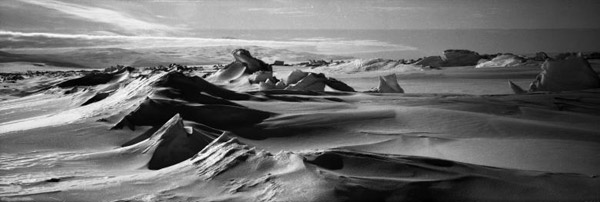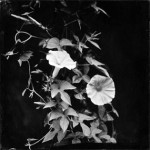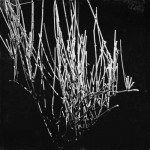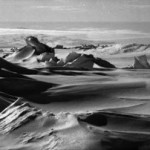In 2005, Joyce Campbell, an interdisciplinary artist coming out of sculpture and most recognized for her photography, taught as a guest professor at Scripps College in 2005 and participated in the Ruth Chandler Williamson Gallery’s tri-annual Faculty Exhibition. Campbell, a native of New Zealand, received her Bachelor in Fine Arts in 1992 from Canterbury University and her Masters in Fine Arts with honors in 1999 from the University of Auckland, where she is currently a professor of fine arts. Campbell, who divides her time between Los Angeles and Auckland, New Zealand, describes her artistic interest as, “making visible micro-contained systems that might otherwise be invisible.” Thus, in early projects such as Bloom, Campbell mapped Los Angeles through bacterial traces. Taking swab samples from each district of Los Angeles, Campbell allowed the microbes to grow in Petri dishes and photographed the resulting dots and blooms. The final contact-printed photographs offer a micro-view of the burgeoning metropolis. Similarly, L.A. Botanical, exhibited in 2006 at the Starkwhite Gallery in Auckland and, in 2007, at the G727 Gallery in Los Angeles, represents the beginning of an ongoing project to document the plant species growing in Los Angeles for which there is a documented use, including “food, medicine, weapon, abortive, analgesic, fuel, stimulant, building material, deadly toxin or mind-altering entheogen.” In this manner, Campbell attempts to show the sustaining plant life growing in the city famed for its concrete highways, car culture and ultimately unsustainable way of life.
Campbell’s most recent project, Last Light: Antarctic Photographs, resulted from her two-week expedition to the Ross Sea region of Antarctica with New Zealand’s Artists to Antarctica Program in the early spring of 2006. The Pitzer Campus Galleries exhibited select works of this project in the Antarctica exhibition from November 17th to January 12th, 2007. Campbell describes this project as “driven by my own burgeoning horror at the effects of climate change on the earth’s polar ice caps.” Through her photographs of the fractures and cracks that have resulted from the melting of the ice shelves, Campbell makes visible the effects of global warming; what she terms a “massive cultural problem.”
For both L.A. Botanical and Last Light, Campbell used anachronistic photographic techniques, which date back to the beginnings of photography in the 19th and early 20th century. In such photographs as Ephedrine and LSA (Lysergic Acid Amide), Campbell used the ambrotype process developed in the 1850s, which creates a positive photographic image on a sheet of glass using the wet plate collodion process. The artist exposes the wet glass plate to light and, once developed and fixed, the negative image appears to be positive when placed against a black background. Due to lower costs, this process replaced the daguerreotype and was widely used for portraits. In this manner, each photograph in L.A. Botanical becomes a portrait of the plant it delicately portrays. For some of her work in Antarctica, Campbell used the daguerreotype process to capture a landscape that humans first viewed long after the invention of the photographic technique. On January 29th, 2008 at the Mallot Commons Tuesday Noon Academy Lecture Series, in a talk entitled, “Antarctic Gothic”, Campbell attributed her use of the daguerreotype to her desire to bring back indisputable proof of the phenomenon of global warming to skeptics. Unlike digital photography, a daguerreotype image cannot be manipulated or even duplicated. Because a daguerreotype plate is developed on the site of exposure, Campbell states that the images are “impervious to a desire to change or resist,” and in this manner can serve as a testament to the terrifying effects of global warming made visible in Antarctica’s glaciers. In addition to daguerreotypes, Campbell shot large-format negatives in order to produce large-scale silver gelatin prints. With these prints, Campbell brings her audience into physical relationship with the Antarctic landscape, which so few people are able to access. The print acquired by the Ruth Chandler Williamson Gallery, Last Light, pulls the viewer into the glistening and desolate landscape allowing her to feel for a moment lost in the expanse of snow and ice; to imagine her own vulnerability and mortality in the extreme cold.
- Joyce Campbell: “LA Botanical,” 2006.
- Joyce Campbell: “LA Botanical,” 2006.
- Joyce Campbell: “Last Light: Pressure Ridge, Scott Base, Antarctica, 2006,” 2006/2007. Silver gelatin print on Paper. Scripps College. Purchase made possible by the Jean and Arthur Ames Fund.
Written by Megan Downing (SC ’08), 2007-08 Academic Year Wilson Intern.





